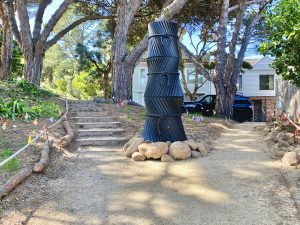
Using one’s imagination, a trip to a farm in England or a reminder of some personal memory, can be as close as the Greenway.
Adam King, 71, a transplant from London to New York to Diamond Street 28 years ago, has been an activist on behalf of growing things and neighborhood beautification for the last 15 years.
In 2008, after an inspiring trip to Burning Man, King and a neighbor formed the Friends of Penny Lane to enhance the stairway at the end of Penny Lane, between Surrey and Sussex Streets, with hardscape and plantings. The neighbors do upkeep as needed and every now and then they add some projects to it that keep it slowly evolving.
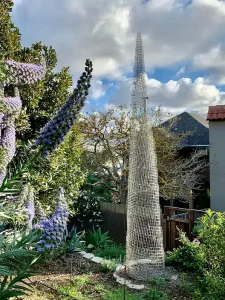
Michael Rice, former Glen Park Association president, came by one day and said he wanted to do something like this over by (what is now) the Greenway.
The Greenway project got underway in 2012 and King has been participating in workdays there ever since.
A retired professional architect, King has also been making sculpture since high school. He works at home in room that has a large skylight. When things get messy, he works in his backyard.
Stouk, one of two or three large sculptures he’s made, has a temporary home on the Greenway. The title refers to bundles of harvested grasses such as corn or rice, stacked together in a field so they don’t fall over.
The purpose of a stouk is to protect the unthreshed grain, hay or straw from moisture before it’s stored. “They were in the fields around my grandparents’ house in the country in the very north of Essex and I was fascinated by them. Being from London, it was so remarkable to have that contrast and see those old ways.”
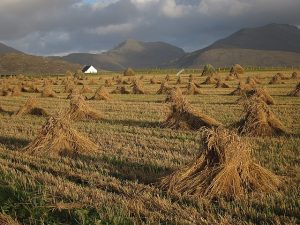
King wasn’t looking to represent a stouk when he began the sculpture. He was experimenting with geometric forms that have a meaning that transcends the geometry. “That’s what I want in the final thing.” In the field stouks are placed side by side and are not very tall. To have the desired impact King had the idea to stack three of them one on top of another.
The finished sculpture is 7-1/2 feet high.
To make Stouk, King used whitewood (“It was the cheapest wood I could find. Wood is now incredibly expensive.”) covered in roofing tar. In addition to providing waterproofing as a practical matter, the slightly shiny blackness of the tar gives a changing and interesting play of light. Besides, his grandparents’ barns had shiplap siding painted with tar.
In the field a stouk is fastened with twisted ties made from the grain. King wanted more complexity to the object and something that people would associate with other things and feelings. For that reason he used some old sisal rope he had laying around.
As an architect, King had several long-term projects in Japan and traveled there around eight times over sixteen years. He was very moved and influenced by the Shinto temples with their decorative tassels and detailing and brought that element into the sculpture with the rope.
King studied architecture in college in Newcastle. Back in London he engaged in numerous community art projects all over the city, including forty mazes in school playgrounds and housing projects. He got his professional degree at the Architectural Association.
“The economy was crap,” he says, so he moved to New York where he worked on massive development projects, before moving to San Francisco. Here he worked at BAR Architects, then Richard Beard Architects, on a range of project types including retail, wineries, custom homes, large developments in China and the trips to Japan to design senior living housing.
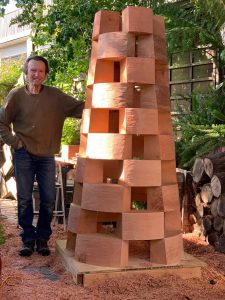
King knows that people will form their own impressions of the elements of the sculpture and how they’ve been fitted together. “Anyone’s interpretations are valid and very individual” he says. “I’ve heard many of them! I called it ‘Stouk’ so that it anchors the sculpture around the idea of harvesting.”
Stouk wasn’t originally made for the Greenway. For awhile it was on the Surrey Steps. A member of the Greenway executive group suggested placing one of King’s sculptures in the Native Meadow (between Brompton and Lippard Avenues). It’s a trial run; if the response is positive the idea is to place a few more sculptures there.
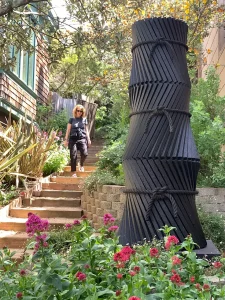
After the April 1 Greenway Work Party there will be a ceremony at noon, at which time Stouk will be dedicated to the Greenway volunteers. Expected to attend are representatives from the San Francisco Parks Alliance, the San Francisco Arts Commission, San Francisco Public Works, and Supervisor Mandelman’s office.
Stouk is approved by the city to be in place for six months but it might be extended so it can remain on the Greenway until an Art Walk SF event in October. When it leaves the Greenway, Stook will be up for auction.
Hopefully it will be followed by another evocative work of art on the Greenway.
Website: Studio Adam King